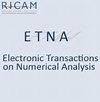分段平滑图像的无参数恢复
IF 1.1
4区 数学
Q3 MATHEMATICS, APPLIED
引用次数: 0
摘要
我们提出了一种新的策略来自动估计用于恢复任务的图像分解变分模型中出现的两个正则化参数,当底层的破坏噪声已知为加性白高斯噪声时。在该模型中,目标图像被分解为分段常量分量和平滑分量,前者用总变化项惩罚,后者用吉洪诺夫项惩罚。该准则依赖于噪声的白度特性,扩展了最初在单一正则化参数情况下引入的残差白度原则。所考虑的分解模型的结构允许对一对未知参数进行有效估计,这些参数可以通过用于数值解的乘法器的交替方向方法沿迭代自动调整。在不同损坏程度的图像上对所提出的多参数残差白度原理进行了测试。所执行的测试突出表明,当从单参数转移到多参数场景时,白度标准特别有效和健壮。本文章由计算机程序翻译,如有差异,请以英文原文为准。
Parameter-free restoration of piecewise smooth images
We propose a novel strategy for the automatic estimation of the two regularization parameters arising in the image decomposition variational model employed for the restoration task when the underlying corrupting noise is known to be additive white Gaussian. In the model of interest, the target image is decomposed in its piecewise constant and smooth components, with a total variation term penalizing the former and a Tikhonov term acting on the latter. The proposed criterion, which relies on the whiteness property of the noise, extends the residual whiteness principle, originally introduced in the case of a single regularization parameter. The structure of the considered decomposition model allows for an efficient estimation of the pair of unknown parameters, that can be automatically adjusted along the iterations with the alternating direction method of multipliers employed for the numerical solution. The proposed multi-parameter residual whiteness principle is tested on different images with different levels of corruption. The performed tests highlight that the whiteness criterion is particularly effective and robust when moving from a single-parameter to a multi-parameter scenario.
求助全文
通过发布文献求助,成功后即可免费获取论文全文。
去求助
来源期刊
CiteScore
2.10
自引率
7.70%
发文量
36
审稿时长
6 months
期刊介绍:
Electronic Transactions on Numerical Analysis (ETNA) is an electronic journal for the publication of significant new developments in numerical analysis and scientific computing. Papers of the highest quality that deal with the analysis of algorithms for the solution of continuous models and numerical linear algebra are appropriate for ETNA, as are papers of similar quality that discuss implementation and performance of such algorithms. New algorithms for current or new computer architectures are appropriate provided that they are numerically sound. However, the focus of the publication should be on the algorithm rather than on the architecture. The journal is published by the Kent State University Library in conjunction with the Institute of Computational Mathematics at Kent State University, and in cooperation with the Johann Radon Institute for Computational and Applied Mathematics of the Austrian Academy of Sciences (RICAM).

 求助内容:
求助内容: 应助结果提醒方式:
应助结果提醒方式:


